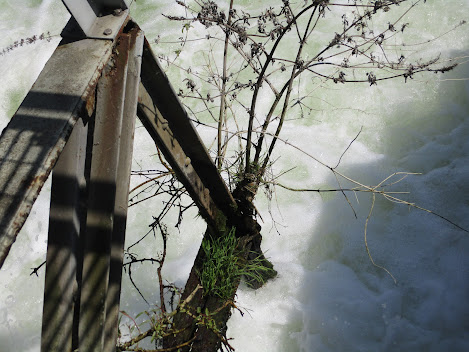"The Force that through the Green Fuse Drives the Flower", is the title of a poem by the Welsh poet, Dylan Thomas, and which can be read as a metaphor for photosynthesis, with chlorophyll as the green fuse "ignited" by sunlight firing a plant into bloom, although the following allusion that it also "...drives my green age" encompasses the whole force and process of aliveness, including that of the writer of those words. I have often marvelled at the urge of nature to bring forth life, and its capacity to do so, even in very inhospitable conditions, where it may cling on precariously, and was struck by these plants, alive, if not all fully thriving, in the fast moving waters of the weir at Caversham Lock, fed by the River Thames.
Most probably, they are rooted in sediment, delivered by the river over time or, as the weir is now quite old, into its foundations. Anyway, here are a few examples of what is growing there, providing an organic interface ("edge", in permaculture terms) between water, steel and concrete.
First a curly- dock (Rumex crispus):
And to the other side of that dock is a grey willow (Salix cinerea), also fixed to the steel frame, but extending roots:
The capacity of nature to bring forth life is a wonder, and a demonstration that our intentions should not be focussed to "Save the Planet" - an almost arrogant view considering the immensity of a planet in comparison with the puny human scale - but that we need to respect Nature to comprehend our place as part of it, and at best save ourselves. The book, "The World Without Us", amply expresses that if we fail to accomplish this, most traces of "us" - the human civilization - will be overwhelmed and erased.
Thus, I am also reminded of the sonnet by Percy Bysshe Shelley, entitled Ozymandias (the name from ancient Greek sources for the pharaoh Ramesses II - "Ramesses the Great"):
"I met a traveller from an antique land,
Who said—“Two vast and trunkless legs of stone
Stand in the desert. . . . Near them, on the sand,
Half sunk a shattered visage lies, whose frown,
And wrinkled lip, and sneer of cold command,
Tell that its sculptor well those passions read
Which yet survive, stamped on these lifeless things,
The hand that mocked them, and the heart that fed;
And on the pedestal, these words appear:
My name is Ozymandias, King of Kings;
Look on my Works, ye Mighty, and despair!
Nothing beside remains. Round the decay
Of that colossal Wreck, boundless and bare
The lone and level sands stretch far away.”
Similarly, I have climbed Mount Nemrut in Turkey - walking along its edge in an almost paralysingly powerful wind - to view its mountain top tomb-sanctuary flanked by huge 8–9-metre high
(26–30 ft) statues of King Antiochus IV of Commagene, two lions, two eagles, and various Greek and Iranian gods, including Heracles-Artagnes-Ares, Zeus-Oromasdes, and
Apollo-Mithras-Helios-Hermes. Although the King felt inclined to thus elevate himself beyond the mortal and into the divine realm, the head of his statue has fallen along with the others, as another metaphor for the flimsy transience of human accomplishments and illusory omnipotence, in the face of amaranthine natural forces that will prevail with or without us.




No comments:
Post a Comment